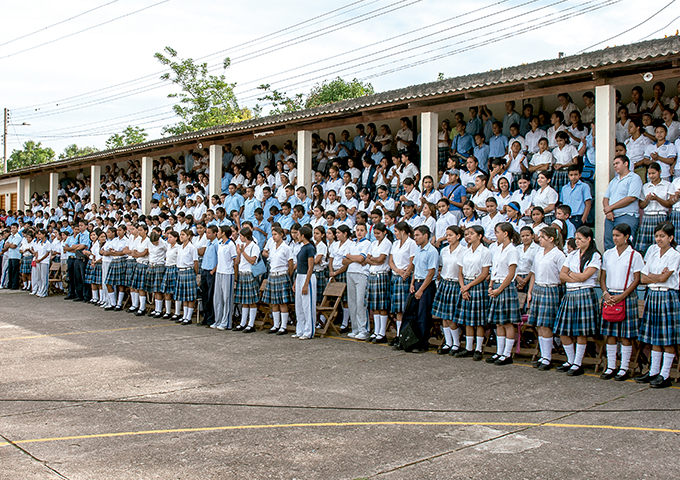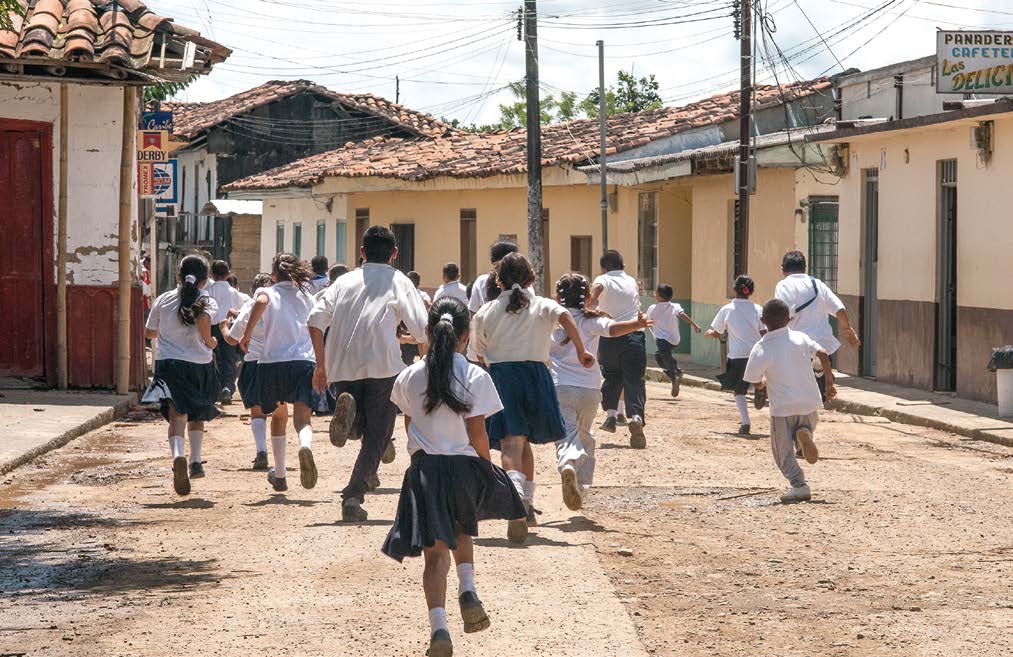Publicly subsidized private schools, a model to evaluate and improve
By: Inés Elvira Ospina Echandía
Photos:
Society and Culture

By: Inés Elvira Ospina Echandía
Photos:
In Colombia, there is the idea that private education is better than public education. The concern to know whether this is true and that about the lack of information to solve it lead Nathalia Urbano, professor at Universidad del Rosario in Colombia, and Claudia Milena Díaz, professor at the University of Toronto, Canada, to investigate, quantitatively and qualitatively, publicly subsidized private schools, one of the educational models of the Public–Private Alliance (APP, for its acronym in Spanish) that exist in the country. Its analysis showed that the premise is not true for this particular model.
“Among our motivations, was to review, in terms of performance and results, the behavior of these schools. We wanted to know how successful the idea was that the private sector works much better than the public one does, that it has higher quality, and that it gets better results. In addition, we wanted to identify the factors that were influencing its functioning and operation,” explains Urbano, professor at the School of Human Sciences.
Publicly subsidized private schools are private schools, wherein the State subsidizes some students who cannot attend because of the lack of capacity in the public system. These preserve all the authority over their processes and decisions and provide the infrastructure and equipment required for the students to operate and carry out of all the activities of school life.
The model is already known in the educational system in Colombia because it has existed since the 19th century, when the state began paying the Catholic Church for training young students. However, the name of publicly subsidized private schools was given after the nineties, when they were regulated by the so-called Education Financing Law, whereunder it is defined that this type of schools can only be subsidized in places where there is insufficient capacity from the public sector.
“There are no studies that report how these schools are doing, what their performance is, or what their results are, and they have a much higher percentage of enrollment than the charter schools,” says Díaz. The researcher remembers that at the time the work of research entitled Effects and Operation of the publicly subsidized private schools in Colombia was proposed, Instituto Colombiano para la Evaluación de la Calidad de la Educación, ICFES (Colombian Institute for the Evaluation of Education Quality) published its annual call to finance research group projects from universities that link the analysis of their databases. “We applied and we won,” she says.
This is how the two professors, with the support of research assistant María Nataly Ortegón, began to work to identify the effect of publicly subsidized private schools on Saber 11 tests from the students who receive the state subsidy. For this analysis, they used two sources: Saber 11 in 2014 and 2015, administered by ICFES, and C600, administered by the Departamento Administrativo Nacional de Estadística, Dane (National Administrative Department of Statistics), in the same years.

In 2014, Cali was the capital with a higher percentage of enrollment in publicly subsidized private schools, with 36 percent of the total tuition financed with public funds, while Bogotá had one of the lowest percentages among capitals, barely 10 percent.
Students and schools with their specific features
Based on the combined primary information of the Saber 11 2014 and 2015 tests and the C600 for the same years, the research study found that publicly subsidized private schools receive subsidized students with public money seeming to present on average a greater vulnerability, which is evidenced by the increased proportion of students from rural areas, whose parents have a lower education attainment; their slightly older age; their lower self-reported monthly household income; and their greater tendency to work.
It is also found that publicly subsidized private schools tend to be more full-time schools, contrary to what happens with public schools, which may indicate a greater learning exposure. Nevertheless, public schools have lower student ratios per teachers and teachers with higher educational level, factors that in theory favor student learning.
“From these results, we designed a qualitative approach to delve into what we had found and decided to study two territorial entities that exhibited some similarities. Then three schools were selected in each city with low, middle, and high performance,” explains Urbano.
The chosen cities were Cali and Bogotá, which have comparable autonomy levels with regard to their educational systems, and which present similar and increasing educational coverage levels for the population of 5-to-17-year-olds.
Despite these similarities, by 2014, Cali was the capital, with a higher percentage of enrollment in publicly subsidized private schools, and with 36 percent of the total tuition financed with public funds, while Bogotá had one of the lowest percentages among capitals, barely 10 percent.
The next step was to design information-gathering instruments. They decided to use focus groups, interviews, and surveys that were performed with policymakers, decision-makers, officials of the Secretariats of Education and the Ministry of National Education, parents, students, teachers, and school directors.
Surprising and not so surprising findings
To obtain better results, the researchers looked for methods that would allow them to show the performance of schools considering socioeconomic conditions of the population. The Propensity Score Matching technique was useful for this, which allowed matching and comparing the performance of students from each of the schools, a publicly subsidized one and a public one, which were as similar as possible in areas such as parents’ education, income levels, age, etc.
After crossing these data, the result was unexpected: The publicly subsidized private schools’ performance was the same as or even lower than that of the public sector. “It is a relevant fact because in Colombia it is assumed that private education is better and even a deal-breaker for parents at the time of enrolling their children in the educational system,” affirms Professor Díaz.
In addition, these differences are not the same throughout the country. According to a majority of the Secretariats of Education performance is worse in publicly subsidized private schools than it is in public schools, with some exceptions.
In the Saber 11 tests, the estimated impacts show that attending a publicly subsidized private schools has a negative effect on the performance of subsidized students. In the areas of mathematics and critical reading, the estimated impacts, controlled by sociodemographic variables and by school variables, show that attending a publicly subsidized private schools has a negative effect on the performance of subsidized students.
Something that also called the attention of the researchers regarding teachers was that professors in publicly subsidized private schools tend to have lower levels of training. However, for Díaz, that was predictable, because their working conditions are more precarious than those for professors in the public sector, who have higher salary levels and more incentives to obtain more training in exchange for increasing their income. This is in addition to having an indefinite contract and other additional benefits.
In contrast to the foregoing, the study also shows a group of publicly subsidized private schools that does not depend on public resources and that instead invests the state subsidy of students in strengthening processes for teachers with Edtraining in innovation and pedagogy strategies, which are reflected in the results of the different tests.
The analysis of the results leaves the researchers with various reflections. The first one is that it cannot be said, at least not without further investigation, that the model is either good or bad or that it has to be eliminated. "It would be easy to say that if the model has bad results, it should be removed, which is what the Ministry of National Education is encouraging. But the issue is not so simple, since there is a problem with the offer distribution. That is, many schools in the territories are not necessarily located where the demand is, and for example, many territorial entities cannot afford a two-hour commute for a student, nor would it be right to do it,” says Díaz.
Also, the variability of circumstances in the national territory leads to another consideration that is no less important: If the subsidy of students is taken away from schools with low performance, which are generally the ones that have fewer resources, they will not be able to continue their work with the rest of the students.
“Therein lies the importance of doing more research on the results of the APPs, allowing comparison in terms of performance, functioning, and operation among all education models, both in publicly subsidized private school as well as in charter school. What is more, it becomes important to study how they vary from one city to another. We found results that opened new research questions based on very specific things, but more inputs are needed to make educational policy recommendations regarding these models and in relation to how to strengthen them to contribute significantly to strengthening the quality of education of the country,” concludes the professor of the School of Human Sciences.